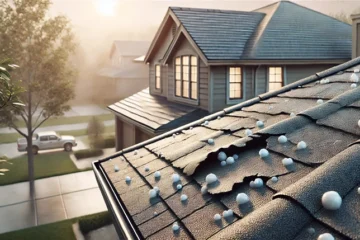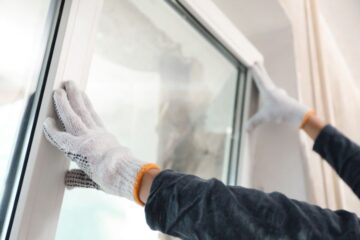Essential Roof Maintenance Tips for Winterizing Your Home Safely
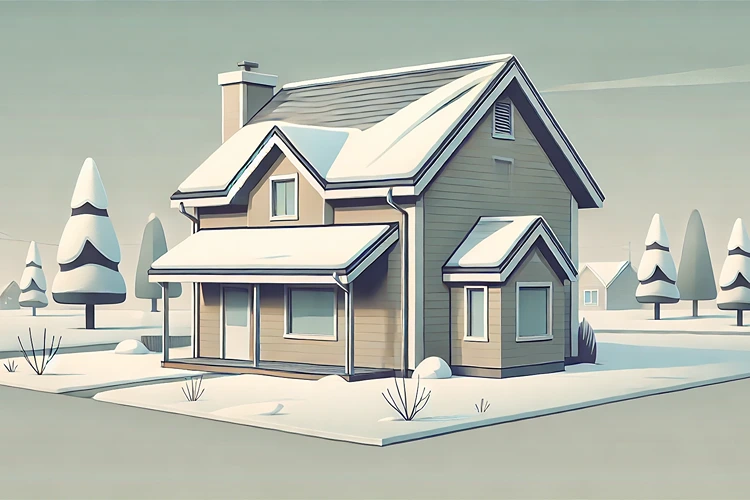
When winter approaches, keeping your home in good shape becomes a top priority, and your roof is one of the most critical parts to maintain. It shields your house from harsh weather conditions, and a well-prepared roof can prevent costly repairs later on. Winterizing your roof doesn’t have to be overwhelming, but there are some key steps you should take to ensure it stays safe and secure. In this guide, we’ll cover practical tips to help you protect your roof and keep your home cozy during the colder months.
Why Is Roof Maintenance Important for Winter?
Before the first snowflake falls, it’s crucial to understand why roof maintenance is vital during winter. Cold weather can be tough on your roof, leading to ice dams, leaks, and structural damage if left unchecked. Winterizing your roof is a proactive approach that minimizes the risk of problems while extending the roof’s lifespan. By addressing issues before they arise, you’ll save yourself from unexpected repairs during the chilly season.
How to Inspect Your Roof for Winter Readiness
The first step in preparing your roof for winter is a thorough inspection. Identifying weak spots and potential hazards early can make all the difference. Here’s what to look for:
- Check for Missing or Damaged Shingles: Damaged shingles can lead to leaks. Ensure they are properly secured, and replace any that are cracked or missing.
- Inspect for Sagging Areas: A sagging roof may indicate structural damage, which can worsen under the weight of snow and ice.
- Look for Cracked Flashing: Flashing protects vulnerable areas, like chimneys and skylights. If cracked or loose, water can easily seep through.
- Examine Gutters: Clogged or damaged gutters can cause water to pool on your roof, leading to leaks or ice dams.
Helpful Hint:
Don’t wait for the first storm to inspect your roof. Schedule a roof check in the fall to give yourself plenty of time to address any issues before winter hits.
How to Clear Debris and Keep Gutters Clean
One of the most overlooked parts of roof maintenance is cleaning. Leaves, branches, and other debris can accumulate on your roof and in your gutters, blocking water from draining properly. In winter, this can lead to ice buildup, which can cause significant damage.
Steps to Clean Your Roof Safely
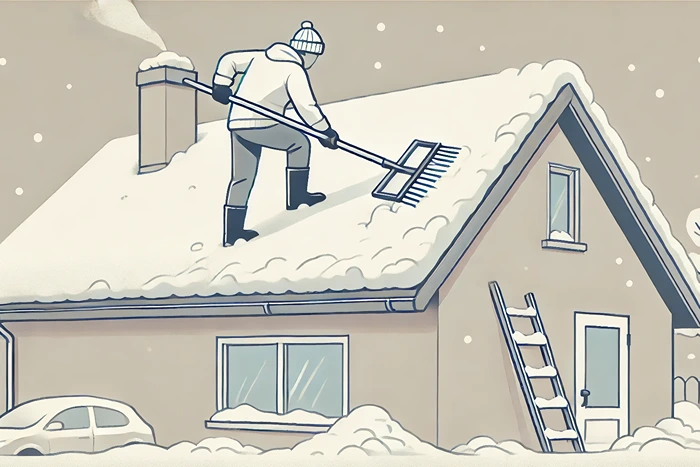
Cleaning your roof might seem like a simple task, but it requires caution, especially if you’re not used to working at heights. Follow these steps to do it safely:
- Use a sturdy ladder and have a friend nearby for assistance.
- Remove large debris with a roof rake or soft-bristle brush. Avoid using anything sharp that could damage shingles.
- Check for moss or algae growth, as this can lead to moisture retention. Consider using a moss removal solution if needed.
- Clean out gutters and downspouts to ensure water flows freely away from the roof and foundation.
Helpful Hint:
After cleaning, install gutter guards to prevent future debris buildup. This will save you from constantly clearing them out, especially during the fall when leaves tend to clog gutters quickly.
Can Ice Dams Damage My Roof?
Ice dams form when heat escapes from your home and melts the snow on your roof, causing water to trickle down and refreeze at the edges. This buildup of ice can prevent water from draining properly, leading to leaks. Preventing ice dams is key to avoiding roof damage.
How to Prevent Ice Dams on Your Roof
Here are a few ways to prevent ice dams and protect your home during winter:
- Ensure your attic is properly insulated to keep warm air inside and reduce snow melting.
- Use a roof rake to remove snow from the edges of your roof before it can refreeze.
- Check your ventilation system. Proper attic ventilation allows cold air to circulate, preventing heat buildup.
- Install ice and water shields on the roof, particularly around valleys and edges, to create a barrier against moisture.
Stats:
A study by the National Roofing Contractors Association found that homes with proper attic insulation and ventilation systems were 40% less likely to experience ice dams during winter storms.
When Should You Call a Professional?
While many roof maintenance tasks can be done on your own, some issues require the expertise of a professional. It’s important to know when it’s time to bring in a roofing expert to ensure your roof is winter-ready. Here are some situations where professional help might be needed:
- If your roof has significant sagging or water damage that could compromise its structure.
- When you notice mold, mildew, or large patches of moss growing on the roof.
- If your roof is older than 20 years and has not been inspected recently, as it may require a more in-depth evaluation.
Hiring a professional can save you from making costly mistakes, especially when it comes to more complicated repairs. They have the tools and expertise to identify problems that may not be visible to the untrained eye.
How to Perform Roof Repairs Before Winter
If you’ve identified any damage during your roof inspection, it’s important to address it before the cold weather sets in. Roof repairs can be done in fall or early winter, but once snow starts falling, it becomes much more difficult—and dangerous. Here are some common repairs you might need to tackle:
Replacing Missing or Damaged Shingles
Shingles protect your roof from the elements, and any gaps can lead to leaks or further damage. If you notice cracked, curling, or missing shingles, it’s time to replace them. Here’s how:
- Remove the damaged shingle by lifting the edges of the surrounding shingles and pulling out the nails.
- Slide the new shingle into place and secure it with roofing nails.
- Make sure to align the new shingle with the surrounding ones for a uniform look and proper coverage.
If you’re not comfortable working on your roof, this is a great task to hire a professional for. They can assess the overall condition of your shingles and ensure that your roof is ready to handle winter weather.
Sealing Leaks Around Flashing
Flashing is used to seal areas where your roof meets structures like chimneys, vents, or skylights. Over time, flashing can crack or pull away, creating gaps where water can seep in. To repair flashing:
- Clean the area around the damaged flashing to remove debris and dirt.
- Apply roofing cement under the edges of the flashing and press it down firmly.
- For larger gaps, consider replacing the flashing entirely to ensure a watertight seal.
Common Winter Roof Damage Causes and Solutions
| Damage Cause | Potential Solution |
|---|---|
| Heavy Snow Accumulation | Use a roof rake to remove snow after heavy storms to reduce the risk of roof collapse or leaks. |
| Ice Dams | Improve attic insulation and ventilation to prevent heat loss and install heating cables along the roof edge if necessary. |
| Clogged Gutters | Clean gutters before winter and install gutter guards to prevent debris buildup and ice formation. |
| Wind Damage | Ensure all shingles are securely fastened, and replace any missing or damaged ones before winter arrives. |
What’s the Best Way to Remove Snow Safely?
Snow removal is another important part of winter roof maintenance. While a small amount of snow is usually harmless, heavy snowfall can put a strain on your roof and lead to structural damage. Here’s how to safely remove snow without damaging your roof:
Using a Roof Rake
A roof rake is a long-handled tool designed to remove snow from your roof without requiring you to climb up there. Here’s how to use it:
- Stand on the ground or a stable ladder, and carefully pull the snow down in small sections.
- Avoid scraping the roof too hard, as this could damage shingles.
- Start at the edge of the roof and work your way toward the middle to prevent snow from piling up in one area.
Be mindful of where the snow lands as you remove it. It’s best to clear a path around your home to avoid snow buildup along the foundation.
When to Hire a Professional for Snow Removal
In some cases, it’s safer to hire a professional to remove snow from your roof, especially if there’s a significant buildup or if your roof has a steep slope. Roofers have specialized equipment to clear snow quickly and safely, reducing the risk of injury or roof damage.
Helpful Hint:
Don’t wait until snow accumulates heavily. Removing snow after each storm prevents ice buildup and reduces the chance of excessive weight on your roof.
How to Improve Roof Insulation for Winter
Proper insulation is key to keeping your home warm in the winter and protecting your roof from the effects of heat loss. When warm air escapes from your house, it can cause snow to melt on your roof and refreeze, leading to ice dams. Here’s how to improve your roof’s insulation:
- Check your attic for any gaps or areas where insulation is lacking.
- Add additional layers of insulation where needed, focusing on areas prone to heat loss.
- Ensure your attic is properly ventilated to allow cool air to circulate and prevent ice dams.
Insulating your roof not only helps with winterization but also improves your home’s energy efficiency, reducing heating costs during the colder months.
Stats:
According to the U.S. Department of Energy, improving attic insulation can reduce your heating bills by up to 15% during the winter months, making it one of the most cost-effective upgrades for homeowners.
How to Handle Gutter Maintenance Before Winter
Gutters play a vital role in directing water away from your roof and foundation. If they’re clogged or damaged, they can cause water to back up onto your roof, increasing the risk of leaks and ice dams. Follow these steps to ensure your gutters are ready for winter:
- Clean out leaves, twigs, and other debris from your gutters and downspouts.
- Check for any cracks or loose connections and repair them as needed.
- Install gutter guards to prevent future clogs, especially if you have a lot of trees around your home.
Properly maintained gutters help water flow away from your home, reducing the risk of water damage both to your roof and your home’s foundation.
Why Attic Ventilation Matters for Winter Roof Care
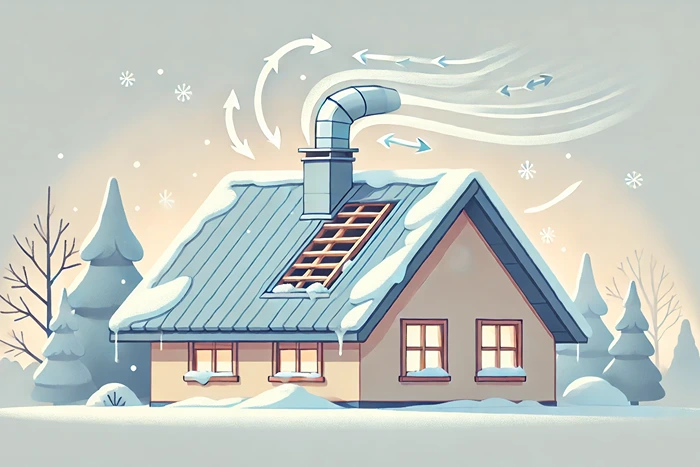
Good attic ventilation is essential to maintaining a healthy roof during winter. It helps control the temperature in your attic, preventing snow on your roof from melting too quickly and forming ice dams. Proper ventilation also helps to prevent moisture buildup, which can lead to mold and wood rot. Here’s what to look for:
- Ensure there’s adequate airflow in your attic by checking your roof’s vents.
- If you notice condensation or moisture buildup, you may need to improve ventilation.
- Consider installing additional vents if your attic tends to stay warm during winter.
Proper ventilation keeps your attic cool and dry, which in turn protects your roof and helps extend its lifespan.
How to Handle Emergency Winter Roof Repairs
No matter how well-prepared your roof is, winter storms can sometimes cause unexpected damage. Whether it’s a fallen branch, ice buildup, or leaks, knowing how to manage emergency repairs is essential. Here are some steps you can take if your roof is damaged during winter:
Temporary Patching for Leaks
If you notice water leaking through your ceiling, the first step is to control the leak and protect your home. Here’s how to do a temporary patch:
- Move furniture and valuables out of the affected area to prevent further damage.
- Use a tarp or plastic sheeting to cover the damaged part of your roof until a permanent repair can be made.
- Place a bucket or container under the leak to catch dripping water and prevent damage to floors and walls.
This temporary fix can hold you over until you can schedule a professional to make a permanent repair. Be sure to monitor the area to avoid further issues, such as mold or structural damage.
Removing Ice Dams in an Emergency
If ice dams form on your roof and begin causing leaks, it’s important to remove them as soon as possible. Here’s how to handle ice dams in an emergency:
- Use a roof rake to gently remove snow from the edges of your roof. Be careful not to damage shingles in the process.
- If the ice dam is too large or difficult to remove, use calcium chloride ice melt to slowly dissolve it. Do not use rock salt, as it can damage your roof.
- Hire a professional if the ice dams are extensive or difficult to access, as they may require specialized tools to remove safely.
Helpful Hint:
If you’re dealing with repeated ice dam issues, consider installing heating cables along the edges of your roof to prevent ice buildup in the future.
When to Replace Your Roof Instead of Repairing It
If your roof has sustained significant damage, or if it’s nearing the end of its lifespan, you may be wondering whether it’s time for a full replacement. Here are some signs that your roof might need to be replaced instead of repaired:
- Your roof is more than 20–25 years old and has experienced repeated issues.
- There are large sections of missing or damaged shingles that make repairs impractical.
- You’ve noticed significant leaks that persist even after multiple repairs.
- The roof structure itself is sagging, indicating possible underlying damage to the rafters or decking.
If you’re unsure whether to repair or replace your roof, a professional roofing contractor can evaluate the situation and give you a recommendation. Sometimes, a full roof replacement is the most cost-effective solution in the long run, especially if repairs are becoming frequent and expensive.
FAQs
Wrapping Up
Taking the time to prepare your roof for winter can save you from unexpected headaches when the cold weather hits. By following these essential roof maintenance tips for winterizing your home safely, you can prevent common issues like leaks, ice dams, and structural damage. Regular inspections, proper insulation, and timely repairs are key to ensuring your roof stays in top shape during the colder months. With these tips, you can enjoy peace of mind knowing your home is protected from the elements, and your roof will last longer, reducing future repair costs.
